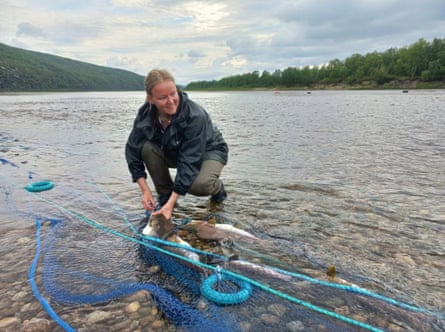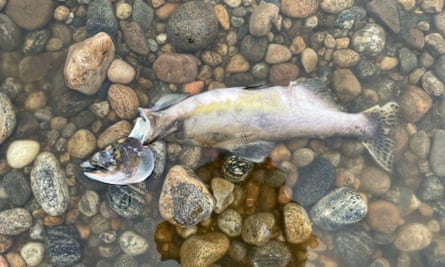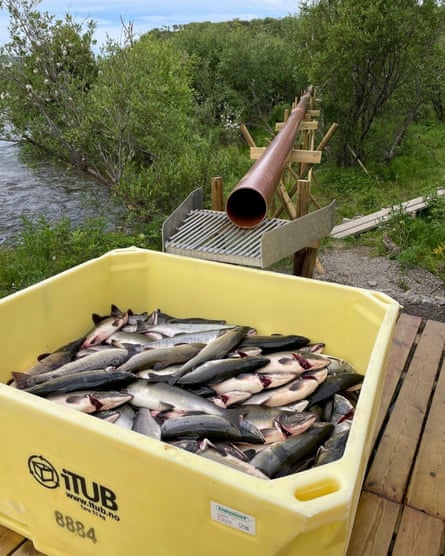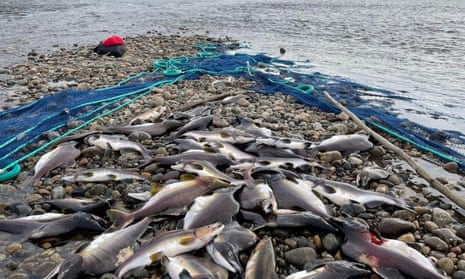Along the border between Norway and Finland lies the world’s greatest Atlantic salmon river. To the Norwegians, it is the Tanaelva or Tana; the Finns call it the Tenojoki or Teno. But to both countries it is known as one of the purest and cleanest rivers, passing through largely unspoiled and unpolluted regions from Finnmark, Norway’s northernmost county, into Lapland.
Now, however, the river’s waters and banks are crowded with rotting fish, their skin peeling away, and the air is thick with the odour of decaying flesh. “It’s a mess. It’s quite dramatic, says Aino Erkinaro, a doctoral researcher from the University of Oulu in Finland. “And, oh man, it smells so bad now.”
The carnage is the result of an invasion – not of Atlantic salmon but Pacific pink salmon, which has prompted both Norway and Finland declare an emergency. Also known as pukkellaks or humpback salmon, for their characteristic bulge, pink salmon were introduced into the Kola peninsula in Russia in the 1950s in an attempt to stimulate the economy. They live in oceans and swim up the same rivers every two years to lay their eggs and then die.

But the fish often stray from the group and find their home elsewhere – and over the years they have moved westwards. Now, as the climate changes, there have been dramatic increases in pink salmon numbers in the north Atlantic – and many end up dead and rotting in the Tana.
The irony of too much salmon in countries that rely so heavily on it has not gone unnoticed. Hypothetically, pink salmon would be good to eat when caught at sea or just after entering the river – meaning mostly in Norwegian territory – but since this species is so new, and smaller than Atlantic salmon, there is no industry for it and only a few people are licensed to fish for it and sell it, says Eirik Frøiland, of the Norwegian Environment Agency.
At the top of the Tana, in Finnish territory, pink salmon soon spawn, die and putrify – meaning the window for catching and eating them is too short, says Tapio Hakaste, of Finland’s agriculture and forestry ministry. It is an invasive species, he says, especially for the Sámi people living in the valley; Atlantic salmon and traditional fishing methods have been a cornerstone of Indigenous culture for centuries.
Experts worry about the impact of the Pacific pink salmon on the local Atlantic species, which are already struggling. So far this year there have been low numbers of Atlantic salmon, sea trout and char caught in several rivers in Norway, causing fishing to be halted before the end of the season.
In Finland, Atlantic salmon numbers had already fallen so low that most fishing of the species has been banned for the past two years. Between 2021 and 2022 the estimated number of female Atlantic salmon in Finnish rivers fell between 42% and 78%, depending on the river, compared with the previous average, according to a national report that called the changes “grim”.
The pink salmon’s effect on the ecosystem of these rivers is still unknown. There are fears the fish could carry pathogens – such as Renibacterium salmoninarum, which causes bacterial kidney disease, and Piscirickettsia salmonis, which causes piscirickettsiosis – that could infect their Atlantic cousins or other elements of the marine ecology. They could also simply outcompete Atlantic salmon, consuming their food sources and occupying their habitat.

In their vast numbers, their rotting bodies provide a vast hit of extra nutrition for fish predators and disproportionately increase their populations. Large numbers of decaying fish throughout autumn could reduce oxygen levels in the water, too, and release unknown nutrients in the river and riverbank soil.
It’s such a concern that Norwegian and Finnish governments – which both have very conservative policies over the protection of local flora and fauna – have worked together to whip up a plan. The Finnish government has encouraged local fishermen and volunteers to fish pink salmon on sight, while Norway subsidised the fishing of the species in dozens of rivers. Most importantly, Norway has blocked all major rivers with a sophisticated fence and floating net trap system, to prevent pink salmon from making it upstream.
Even the Chinese tech firm Huawei has become involved, using a kind of facial recognition AI to block pink salmon while letting Atlantic salmon through. The Norwegian government plans a competition to fund AI solutions such as these ahead of the next invasion, which is expected in two years.

“All the traps seem to work very well,” says Johan Henrik Hårdensson Berntsen, a researcher at the Norwegian Institute for Nature Research, who is in charge of monitoring the number of pink salmon that have been caught – more than 239,000 so far.
In the Tana, the operation isn’t going as swimmingly. Only about 8,000 fish have been caught and the trap has been opened on several occasions because it was stopping Atlantic salmon, too.
“They have not succeeded very well. We have now seen around 120 to 130,000 pinks migrating through the Tana system, past our monitoring site after the dam,” says Panu Orell, a research scientist at the Natural Resources Institute in Finland. That’s twice the number as in 2021, he adds.
Orell’s team uses sonar monitoring 55km (34 miles) from the river mouth, as well as localised underwater video cameras, to count the fish. The number is the “tip of an iceberg”, he says, citing predictions that Finland could be invaded by several million pink salmon in years to come. “We’re just seeing the beginning.”
Research from Russian scientists, who have been monitoring pink salmon in their rivers for decades, suggests the species can coexist with native salmon in some rivers, according to Katherine Dunlop, a researcher at the Norwegian Institute of Marine Research. But not enough is yet known about the issue. “There’s a big list of questions. There are some positives and there are some negative effects,” says Dunlop. “Each river system can be quite different.”
Her team is researching pink salmon in the Jakobselva, the river that follows the border between Norway and Russia, and the only one where Norwegian authorities cannot put traps for the fish. So far, they have found that most hatched fry are swept down to the sea without stealing food from native fish – though some also spend time in estuaries first.
What’s more, Atlantic salmon young have been feeding on the eggs of pink salmon, while ravens, crows and seagulls are feeding on the carcasses – not to mention red foxes and brown bears, whose populations could jump as a result without other predators to keep them in check.
“This is an unknown sort of ecological situation,” says Dunlop. “You have this sort of balance – ‘is it a pest or is it a resource?’”
Erkinaro, who is working with citizen scientists to track where pink salmon go when they die, is studying nutrient levels in the water, asking questions such as: “When the fish rot, can you see the effects in two weeks? Two months? It’s hard to imagine that there would be no effect on the nutrient concentrations,” she says, given the sheer numbers of invasive fish involved.
Meanwhile, she says Norway and Finland will both need to make some changes – whether that’s implementing new rules to protect local ecosystems, or using pink salmon as another sustainable food source and changing their commercial fishing strategies. It’s probably only a matter of time before they cross to Denmark, the Baltic Sea and even to Britain.
“One thing is for sure, though – this is it,” she says. “The pink salmon are here to stay.”
